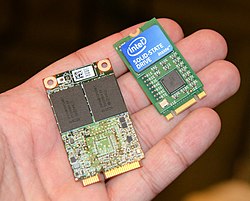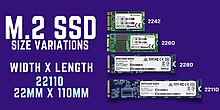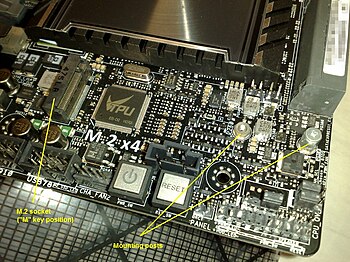M.2
 An M.2 2280 solid-state drive (SSD), 22 mm wide and 80 mm long | |
| Connects to | Motherboard via one of:
|
|---|---|
| Common manufacturers | Intel Phison Realtek Samsung Silicon Motion SK Hynix |
| Design firm | PCI-SIG |
| Introduced | November 1, 2013 |
| Dimensions |
|

M.2, pronounced m dot two[1] and formerly known as the Next Generation Form Factor (NGFF), is a specification for internally mounted computer expansion cards and associated connectors. M.2 replaces the Mini SATA (mSATA) standard and the Mini PCIe (mPCIe) standard (which is how it got the short name of M dot 2 from being Mini SATA 2). Employing a more flexible physical specification, M.2 allows different module widths and lengths, which, paired with the availability of more advanced interfacing features, makes M.2 more suitable than mSATA in general for solid-state storage applications, particularly in smaller devices such as ultrabooks and tablets.[2][3][4]
Computer bus interfaces provided through the M.2 connector are PCI Express x4 (up to four lanes), Serial ATA 3.0, and USB 3.0 (a single logical port for each of the latter two). It is up to the manufacturer of the M.2 host or module to select which interfaces are to be supported, depending on the desired level of host support and the module type. Different M.2 connector keying notches denote various purposes and capabilities of both the M.2 hosts and modules, and also prevent the M.2 modules from being inserted into incompatible host connectors.[2][3][5]
The M.2 specification supports NVM Express (NVMe) as the logical device interface for M.2 PCI Express SSDs, in addition to supporting legacy Advanced Host Controller Interface (AHCI) at the logical interface level. While the support for AHCI ensures software-level backward compatibility with legacy SATA devices and legacy operating systems, NVM Express is designed to fully utilize the capability of high-speed PCI Express storage devices to perform many I/O operations in parallel.[2]: 14 [6]
Features
[edit]
M.2 modules can integrate multiple functions, including the following device classes: Wi-Fi, Bluetooth, satellite navigation, near field communication (NFC), digital radio, WiGig, wireless WAN (WWAN), and solid-state drives (SSDs).[7] The SATA revision 3.2 specification, in its gold revision as of August 2013[update], standardizes M.2 as a new format for storage devices and specifies its hardware layout.[2]: 12 [8] Buses exposed through the M.2 connector include PCI Express (PCIe) 3.0 and newer, Serial ATA (SATA) 3.0 and USB 3.0; all these standards are backward compatible.
The M.2 specification provides up to four PCI Express lanes and one logical SATA 3.0 (6 Gbit/s) port, and exposes them through the same connector so both PCI Express and SATA storage devices may exist in the form of M.2 modules. Exposed PCI Express lanes provide a pure PCI Express connection between the host and storage device, with no additional layers of bus abstraction.[9] PCI-SIG M.2 specification, in its revision 1.0 as of December 2013[update], provides detailed M.2 specifications.[2]: 12 [10]
Storage interfaces
[edit]Three options are available for the logical device interfaces and command sets used for interfacing with M.2 storage devices, which may be used depending on the type of M.2 storage device and available operating system support:[2]: 14 [6][9]
- Legacy SATA
- Used for SATA SSDs, and interfaced through the AHCI driver and legacy SATA 3.0 (6 Gbit/s) port exposed through the M.2 connector.
- PCI Express using AHCI
- Used for PCI Express SSDs and interfaced through the AHCI driver and provided PCI Express lanes, providing backward compatibility with widespread SATA support in operating systems at the cost of lower performance. AHCI was developed when the purpose of a host bus adapter (HBA) in a system was to connect the CPU/memory subsystem with a much slower storage subsystem based on rotating magnetic media; as a result, AHCI has some inherent inefficiencies when applied to SSD devices, which behave much more like RAM than like spinning media.
- PCI Express using NVMe
- Used for PCI Express SSDs and interfaced through the NVMe driver and provided PCI Express lanes, as a high-performance and scalable host controller interface designed and optimized especially for interfacing with PCI Express SSDs. NVMe has been designed from the ground up, capitalizing on the low latency and enhanced parallelism of PCI Express SSDs, and complementing the parallelism of contemporary CPUs, platforms and applications. At a high level, primary advantages of NVMe over AHCI relate to NVMe's ability to exploit parallelism in host hardware and software, based on its design advantages that include data transfers with fewer stages, greater depth of command queues, and more efficient interrupt processing.
Form factors and keying
[edit]


The M.2 standard is based on the mSATA standard, which uses the existing PCI Express Mini Card (Mini PCIe) form factor and connector. M.2 adds the possibility of larger printed circuit boards (PCBs), allowing longer modules and double-sided component population. Consequently, M.2 SSD modules can provide double the storage capacity within the footprint of an mSATA device.[2]: 20, 22–23 [4][13]
M.2 modules are rectangular, with an edge connector on one side and a semicircular mounting hole at the center of the opposite edge. The edge connector has 75 positions with up to 67 pins, employing a 0.5 mm pitch and offsetting the pins on opposing sides of the PCB from each other. Each pin on the connector is rated for up to 50 V and 0.5 A, while the connector itself is specified to endure 60 mating cycles.[14]: 6 However, many M.2 slots (Socket 1, 2 and 3) found on motherboards only provide up to 3.3 V power.[15][16][17]
The M.2 standard allows module widths of 12, 16, 22 and 30 mm, and lengths of 16, 26, 30, 38, 42, 60, 80 and 110 mm. Initial line-up of the commercially available M.2 expansion cards is 22 mm wide, with varying lengths of 30, 42, 60, 80 and 110 mm.[3][5][14][18] The codes for the M.2 module sizes contain both the width and length of a particular module; for example, "2242" as a module code means that the module is 22 mm wide and 42 mm long, while "2280" denotes a module 22 mm wide and 80 mm long.
An M.2 module is installed into a mating connector provided by the host's circuit board, and a single mounting screw secures the module into place. Components may be mounted on either side of the module, with the actual module type limiting how thick the components can be; the maximum allowable thickness of components is 1.5 mm per side, and the thickness of the PCB is 0.8 mm ± 10%.[10] Different host-side connectors are used for single- and double-sided M.2 modules, providing different amounts of space between the M.2 expansion card and the host's PCB.[4][5][14] Circuit boards on the hosts are usually designed to accept multiple lengths of M.2 modules, which means that the sockets capable of accepting longer M.2 modules usually also accept shorter ones by providing different positions for the mounting screw.[19][20]
| Key ID |
Notched pins |
Provided interfaces | Dimensions | Uses |
|---|---|---|---|---|
| A (Socket 1) | 8–15 | 2 of PCIe ×1, USB 2.0, I2C and DP ×4 | 1630, 2230, 3030 | Wi-Fi, WWAN, GPS, Bluetooth, NFC |
| B (Socket 2) | 12–19 | SATA, PCIe ×2, USB 2.0 and 3.0, audio, UIM, HSIC, SSIC, I2C and SMBus | 2230, 2242, 2260, 2280, 22100 | SSD |
| C | 16–23 | Reserved for future use | ||
| D | 20–27 | |||
| E (Socket 1) | 24–31 | 2 of PCIe ×1, USB 2.0, I2C, SDIO, UART, PCM and CNVi | 1630, 2230, 3030 | Wi-Fi, WWAN, GPS, Bluetooth, NFC |
| A+E (Socket 1) | 8–15 and 24–31 | 2 of PCIe ×1, USB 2.0 and CNVi | 1630, 2230, 3030 | Wi-Fi, WWAN, GPS, Bluetooth, NFC |
| F | 28–35 | Future Memory Interface (FMI) | ||
| G | 39–46 | Reserved for custom use (unused in the M.2 specification) | ||
| H | 43–50 | Reserved for future use | ||
| J | 47–54 | |||
| K | 51–58 | |||
| L | 55–62 | |||
| M (Socket 3) | 59–66 | SATA, PCIe ×4, and SMBus | 2230, 2242, 2260, 2280, 22100 | SSD |
| B+M (Socket 2) | 12-19 and 59–66 | SATA, PCIe ×2, and SMBus | 2230, 2242, 2260, 2280, 22100 | SSD |
| Type ID |
Top side |
Bottom side |
|---|---|---|
| S1 | 1.20 mm | — |
| S2 | 1.35 mm | — |
| S3 | 1.50 mm | — |
| D1 | 1.20 mm | 1.35 mm |
| D2 | 1.35 mm | 1.35 mm |
| D3 | 1.50 mm | 1.35 mm |
| D4 | 1.50 mm | 0.70 mm |
| D5 | 1.50 mm | 1.50 mm |

The PCB of an M.2 module provides a 75-position edge connector; depending on the type of module, certain pin positions are removed to present one or more keying notches. Host-side M.2 connectors (sockets) may populate one or more mating key positions, determining the type of modules accepted by the host; as of April 2014[update], host-side connectors are available with only one mating key position populated (either B or M).[5][14][11] Furthermore, M.2 sockets keyed for SATA or two PCI Express lanes (PCIe ×2) are referred to as "socket 2 configuration" or "socket 2", while the sockets keyed for four PCI Express lanes (PCIe ×4) are referred to as "socket 3 configuration" or "socket 3".[2]: 15 [24]
For example, M.2 modules with two notches in B and M positions use up to two PCI Express lanes and provide broader compatibility at the same time, while the M.2 modules with only one notch in the M position use up to four PCI Express lanes; both examples may also provide SATA storage devices. Similar keying applies to M.2 modules that utilize provided USB 3.0 connectivity.[5][11][25]
Various types of M.2 modules are denoted using the "WWLL-HH-K-K" or "WWLL-HH-K" naming schemes, in which "WW" and "LL" specify the module width and length in millimeters, respectively. The "HH" part specifies, in an encoded form, whether a module is single- or double-sided, and the maximum allowed thickness of mounted components; possible values are listed in the right table above. Module keying is specified by the "K-K" part, in an encoded form using the key IDs from the left table above; it can also be specified as "K" only, if a module has only one keying notch.[5][14]
Beside socketed modules, the M.2 standard also includes the option for having permanently soldered single-sided modules.[14]
Alternative standards
[edit]NGSFF
[edit]In 2017, Samsung introduced a new form factor called Next Generation Small Form Factor (NGSFF), also known as NF1 or M.3, which may replace U.2 in server applications.[26] The NGSFF connector is electrically and dimensionally compatible with M.2 (revision 1.1)'s connector; new functionality is achieved through previously unused (N/C) pins.[27] The main changes compared to M.2 are:
- The width (or "height") of the SSD is increased from 22 mm to 30.5 mm; the thickness is increased from 3.88 mm to 4.38 mm. These changes allow more NAND chips to be fitted onto an SSD while still fitting inside a rack unit.[28]
- New pins for 12 V power. Devices are supposed to mainly use 12 V power instead of the old 3.3 V, which has been made optional.[28]
- Ability to run two PCIe ports (each with two lanes) on one NGSFF port.[27]
- Features for rackmount servers: hotswap support, indicator LEDs, SSD tray (with new screw holes).[27]
In 2018, the PCI-SIG issued a warning that NGSFF's new pin usage clashes with the pin usage in the upcoming 1.2 revision of the M.2 standard. The new revision uses some of the previously non-connected (N/C) pins to deliver 1.8 V power and USB 2.0 data on the "M" socket. Samsung has sought to standardize its NGSFF/NF1 through JEDEC, but the process appears to have stalled.[29]
XFM
[edit]JEDEC JESD233 is another specification called Crossover Flash Memory (XFM) for XFM Embedded and Removable Memory Devices (XFMD). It targets to replace the M.2 form factor with a significantly smaller one (also called XT2), so that it can also be designed as an alternative to soldered memory. XFM Express utilizes a NVMe logical interface over a PCI Express physical interface.[30][31]
Gallery
[edit]-
An M.2 2242 SSD connected into a USB 3.0 adapter and connected to a computer
-
A docking station for M.2 modules
-
The connection slot of the docking station
-
A Samsung 980 PRO PCIe 4.0 NVMe SSD with 1 TB of storage capacity
-
M.2 2230 (left) and M.2 1630 WiFi cards
See also
[edit]- Enterprise and Data Center Standard Form Factor (EDSFF)
- List of interface bit rates
- NVM Express (NVMe)
- Solid-state drive § Configurations
- U.2
References
[edit]- ^ Gillis, Alexander S. (July 2021). "Definition: M.2 SSD". TechTarget. Retrieved 24 February 2022.
- ^ a b c d e f g h i Handy, Jim; Tanguy, Jon; May, Jaren; Akerson, David; Kim, Eden; Coughlin, Tom (20 September 2014). "SNIA Webcast: All About M.2 SSDs" (PDF). SNIA. Retrieved 15 July 2015.
- ^ a b c "SATA M.2 Card". SATA-IO. Retrieved 14 September 2013.
- ^ a b c Kyrnin, Mark. "What Is M.2? New Interface and Form Factor For Compact SSD Drives in Laptops and Desktops". compreviews.about.com. Archived from the original on 15 July 2015. Retrieved 15 July 2015.
- ^ a b c d e f g h "M.2 Connector (NGFF) Introduction" (PDF). ATTEND. Archived from the original (PDF) on 3 February 2014. Retrieved 17 January 2014.
- ^ a b c Landsman, Dave (9 August 2013). "AHCI and NVMe as Interfaces for SATA Express Devices – Overview" (PDF). SATA-IO. Retrieved 15 July 2015.
- ^ "SATA-IO FAQ: What is the M.2 card and what is the status of the specification?" (PDF). SATA-IO. 8 August 2013. p. 2. Retrieved 15 July 2015.
- ^ "Serial ATA Revision 3.2 (Gold Revision)" (PDF). KnowledgeTek. SATA-IO. 7 August 2013. pp. 194–209. Archived from the original (PDF) on 27 March 2014. Retrieved 15 July 2015.
- ^ a b Wassenberg, Paul (19 June 2013). "SATA Express: PCIe Client Storage" (PDF). SATA-IO. Retrieved 2 October 2013.
- ^ a b "PCI Express M.2 Specification Revision 1.0". PCI-SIG. 2013. Retrieved 14 December 2013.
- ^ a b c Marshall R. (7 April 2014). "Buying an M.2 SSD? How to tell which is which?". Republic of Gamers. ASUS. Archived from the original on 27 April 2014. Retrieved 28 April 2014.
- ^ "Which SSD is Compatible with PS5?". Gaming Console 101. 29 March 2023. Retrieved 2 April 2023.
- ^ "M.2 Frequently Asked Questions". Kingston Technology. Retrieved 15 July 2015.
- ^ a b c d e f g h "M.2 (NGFF) Quick Reference Guide" (PDF). Tyco Electronics. Retrieved 16 November 2013.
- ^ https://media.digikey.com/pdf/Data%20Sheets/Viking%20PDFs/PSFNP5xxxx5xxx_C.pdf [bare URL PDF]
- ^ https://www.nxp.com/docs/en/application-note/AN13049.pdf [bare URL PDF]
- ^ https://www.intel.com/content/dam/www/public/us/en/documents/product-specifications/ssd-530-m2-specification.pdf [bare URL PDF]
- ^ Mujtaba, Hassan (2 July 2013). "Intel SSD 530 Series Arriving Next Week – Feature NGFF M.2 Interface". Wccftech. Retrieved 14 September 2013.
- ^ "M2P4S M.2 (NGFF) PCIe base SSD to PCIe ×4 Adapter". HW Tools. 14 February 2014. Retrieved 22 June 2014.
- ^ Burek, John (14 April 2015). "2015 Guide: The Best M.2 Solid-State Drives". Computer Shopper. Archived from the original on 28 December 2015. Retrieved 15 July 2015.
- ^ "SMBus interface for SSD Socket 2 and Socket 3 (PCI-SIG engineering change notice)" (PDF). PCI-SIG. 11 August 2014. p. 2. Archived from the original (PDF) on 14 July 2015. Retrieved 5 August 2015.
- ^ "How to distinguish the differences between M.2 cards". Dell. Retrieved 24 March 2020.
- ^ "PCI Express M.2 Specification, Revision 1.0" (PDF). PCI-SIG. 1 November 2013. p. 23. Archived from the original (PDF) on 18 January 2021. Retrieved 13 June 2020.
- ^ Zhang, Jack; Liang, Mark (4 July 2015). "NVM Express Based Solid-State Drives: Crossing the Chasm, Going Mainstream" (PDF). Intel. p. 39. Archived from the original (PDF) on 5 June 2016. Retrieved 27 August 2015.
- ^ Tokar, Les (24 November 2013). "Understanding M.2 NGFF SSD standardization (or the lack of)". The SSD Review. Retrieved 28 April 2014.
- ^ Hensel, Martin; Graefen, Rainer (27 July 2018). "Was sind NF1, M.3 und NGSFF?". StorageInsider (in German). Vogel Communications Group. Archived from the original on 10 July 2022. Retrieved 10 July 2022.
- ^ a b c Wang, David. "Next Generation Small Form Factor (NGSFF) SSD Proposal" (PDF).
- ^ a b "NF1 SSD | Samsung Semiconductor". Samsung. Archived from the original on 2 October 2020.
- ^ Tallis, Billy. "PCI-SIG Warns Of Incompatibilities Between M.2 And Samsung's NGSFF/NF1". www.anandtech.com.
- ^ Lee, Matthew (28 August 2021). "Move over M.2, here comes the XFM memory specification - And it might displace soldered storage, too, with some luck". TechSpot. Archived from the original on 10 July 2022. Retrieved 10 July 2022.
- ^ Liu, Zhiye (6 August 2019). "Toshiba Unveils XFMEXPRESS Form Factor for NVMe SSDs". Tom's Hardware. Retrieved 10 July 2022.
External links
[edit]- Serial ATA International Organization (SATA-IO) official website
- Peripheral Component Interconnect Special Interest Group (PCI-SIG) official website
- Understanding M.2, the interface that will speed up your next SSD, Ars Technica, February 9, 2015, by Andrew Cunningham
- LFCS: Preparing Linux for nonvolatile memory devices, LWN.net, April 19, 2013, by Jonathan Corbet
- PCIe SSD 101: An Overview of Standards, Markets and Performance, SNIA, August 2013, archived from the original on February 2, 2014
- M.2 Pinout Descriptions and Reference Designs, January 28, 2020, an application note from Congatec
- Interface card mount – US patent 20130294023, November 7, 2013, assigned to Raphael Gay





